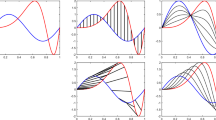Abstract
A two-dimensional shape as considered in this paper is the equivalence class of closed polygons under rigid motions (rotations and translations). We discuss a model for random shapes which is used as the basis for probabilistic classifiers. A maximum-likelihood approach is used to deal with the incomplete information given by the knowledge of the equivalence class only. As an example, the problem of the recognition of species of plants from the shape of their leaves is studied.
Similar content being viewed by others
References
Y. Amit, U. Grenander and M. Piccioni, Structural image restoration through deformable templates, J. Amer. Stat. Assoc. 86(1991)376–387.
A. Bengtsson and J.-O. Eklundh, Shape representation by multiscale contour approximation, IEEE Trans. PAMI 13(1991)85–93.
H. Cramer and M.R. Leadbetter,Stationary and Related Stochastic Processes (Wiley, New York, 1967).
D. Cyganski and R.F. Vaz, Generation of affine invariant local contour feature data, Pattern Recognition Lett. 11(1990)479–483.
G. Freud,Orthogonale Polynome (Birkhauser, Basel, 1969).
A. Gabe, Stationäre Gaußprozesse in der Ebene und ihre Anwendung in der Statistischen Bildanalyse, Diplomarbeit, Universität Giessen (1988).
U. Grenander,Pattern Synthesis (Vol. I), Pattern Analysis (Vol. II), Applied Math. Sciences (Springer, New York, 1976–1977).
U. Grenander, Advances in Pattern Theory, The 1985 Rietz Lecture, Ann. Stat. 17(1985)1–30.
D.M. Himmelblau,Applied Nonlinear Programming (McGraw-Hill, New York, 1972).
R. Lenz, Group theoretical methods in image processing, Lecture Notes in Comp. Sci. 413 (1990).
D.G. Kendall, A survey of the statistical theory of shape, Stat. Sci. 4(2)(1989)87–120.
L.H. Koopmans,The Spectral Analysis of Time Series (Academic Press, New York/London, 1974).
D.H. McLain, Vector approximation to curves, Comp. J. 21(1978)176–177, Algorithm 100.
W.J. Park, A multiparameter Gaussian process, Ann. Math. Stat. 41(1970)1582–1595.
A. Zilinskas,Global Optimization (Mokslas, Vilniusm 1986), in Russian.
Pavlidis,Structural Pattern Recognition (Springer, Berlin/Heidelberg/New York, 1977).
Author information
Authors and Affiliations
Rights and permissions
About this article
Cite this article
Pflug, G.C. Random planar shapes and their statistical recognition. Ann Math Artif Intell 13, 267–279 (1995). https://doi.org/10.1007/BF01530831
Issue Date:
DOI: https://doi.org/10.1007/BF01530831



